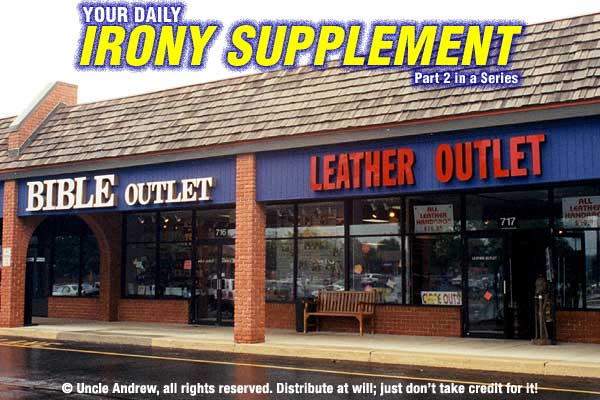Learn To Love Your Loan Shark
 Uncle Andrew
Uncle Andrew
So, have you heard about the latest Supreme Court decision? They’ve decided that, under the Truth In Lending Act, statutory damage awards against fraudulent lenders shall be capped.
The case that spurred this decision, Koons Buick Pontiac GMC, Inc. vs Nigh, is—to cop a term from the automotive world—a classic. Guy buys used Chevy Blazer from a car dealership, swings decent financing deal with his old pickup truck as a trade-in, drives off the lot. Two days later, car dealership calls and tells him that he has to give them an additional 2,000 bucks to secure loan. Man refuses, is told that dealership will call the police and have him picked up for auto theft unless he gives them the extra dough. Man sues under the Truth In Lending Act, and after being coutersued by dealership for breach of contract is awarded $24,000.00, plus attorney’s fees.
Of course, rather than packing it in and admitting defeat—and backed by banking industry lawyers—the dealership appealed the decision. Two lower courts agreed with the first court’s rulings. Finally, in what many have called a landmark decision, the Supreme Court ruled that the amended Truth in Lending Act only entitles the wronged party to between 100 and 1,000 dollars in damage awards. Until now, the common interpretation of the Act allowed for damages up to twice the total value of the finance charges, plus legal fees.
The banking industry is, of course, jubilant. One flack said publicly that this could save the industry billions in judgements resulting from fraudulent TIL lawsuits.
Excuse me, did you say billions? Mind you, I’m just a civillian here, not a financial or legal analyst, but when I hear that an industry could face billions of dollars in court-awarded damages, I tend to assume that there are, at the least, millions of dollars in bona fide damages at stake. I mean, whatever your personal feelings about the overall structure and dynamic of the tobacco settlement, you certainly can’t deny that the tobacco lords were complicit in decades of glossing over and actively supressing the health risks associated with smoking. Billions or not, that’s gotta boil down to a whole holy crapload of liability, which in this society means compensatory damages. So if there are potentially “billions” of dollars in damages to be awarded to victims of shifty lenders (or at least there were, before this Supreme Court ruling), I take it that there are—er, “were”—instances of genuinely abusive or deceptive lending practices, worth millions of dollars in damages, actually taking place. Also bear in mind that this case, and the Supreme Court decision therefrom, involves only non-mortgage loans; we’re only talking about fraud in the lending of money for cars, boats, home entertainment centers, etc. So this isn’t a question of bad lending practices on the sale of, oh, say, The Trump Tower alone.
Let’s assume that “billions of dollars” in undeserved damages means two billion dollars. The total projected price tag for the decision against Koons Buick Pontiac GMC, including all awards, fees, etc., was $54,000. Taking that 54 grand as a median judgement, that would mean that, according to the banking industry, over thirty-seven thousand successfully prosecuted specious Truth In Lending Act lawsuits are at stake. the time period over which this rape of helpless financial institutions would take place was not made clear, but the implications are nonetheless staggering.
The first one that comes to mind being, if there are 37,000 phony lawusuits waiting in the wings, how many real ones must there be?
The second and more obvious question is this: is there really a human being on the face of this planet who would take the word of a banking industry lawyer, let alone that of a car salesman, over that of an average citizen?



